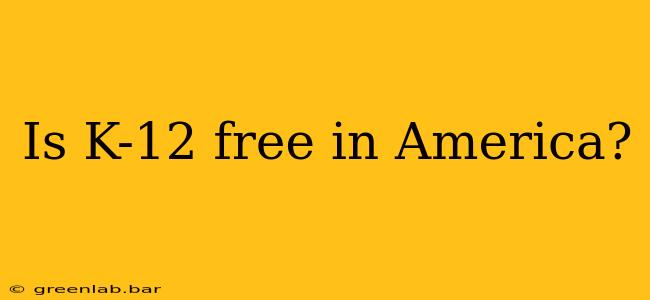The short answer is: yes, K-12 public education is generally free in America. However, this seemingly straightforward answer belies a complex reality shaped by funding mechanisms, state variations, and hidden costs that can significantly impact families. Understanding the nuances of this "free" system is crucial for parents and policymakers alike.
The Public Funding Model: A Decentralized System
Public K-12 education in the United States is primarily funded through a combination of federal, state, and local sources. This decentralized system contributes to the significant variations in school quality and resources across the country.
-
Federal Funding: The federal government provides a relatively small percentage of overall funding, often targeted towards specific programs like special education, Title I (for low-income schools), and school lunch programs. These funds are essential but don't cover the majority of school budgets.
-
State Funding: State governments play a larger role, allocating funds based on formulas that often consider student enrollment and local property values. This can lead to disparities, with wealthier districts receiving more funding than their less affluent counterparts.
-
Local Funding: Local property taxes are a significant source of funding for most school districts. This creates a direct link between property values and school funding, exacerbating inequalities between wealthy and impoverished communities. A district with high property values can generate substantially more revenue than a district with lower property values, even with a similar number of students.
The Illusion of "Free": Hidden Costs and Financial Burdens
While tuition is not charged, families often face significant indirect costs associated with public K-12 education. These "hidden costs" can create substantial financial burdens, particularly for low-income families.
Examples of Hidden Costs:
- School Supplies: Textbooks, notebooks, pencils, and other essential supplies are typically not provided, leaving parents responsible for purchasing them. This can amount to hundreds of dollars per child annually.
- Extracurricular Activities: Participation in sports, clubs, and other extracurricular activities often involves fees for uniforms, equipment, travel, and other expenses.
- Transportation: While some districts provide free bus transportation, others do not, leaving families to arrange and pay for their children's transportation to and from school.
- Technology Fees: Many schools now require students to have access to computers and technology, either through personal devices or school-provided rentals, creating further expense.
- Fundraising: Schools frequently rely on fundraising initiatives to supplement their budgets, putting pressure on parents to contribute financially.
Addressing Inequalities in Funding: Ongoing Challenges
The disparities in funding across school districts are a major concern, leading to significant inequalities in educational opportunities. Students in wealthier districts often have access to better resources, smaller class sizes, and more advanced programs than their counterparts in underfunded districts.
Efforts to address these inequalities are ongoing, involving debates about equitable funding formulas, increased state and federal funding, and the role of property taxes in school finance. Policy changes aiming for greater equity are frequently met with political resistance and complex legal challenges.
Conclusion: Understanding the True Cost of "Free" Education
While K-12 public education in America is tuition-free, it's crucial to acknowledge the substantial hidden costs that can significantly impact families. The decentralized funding model and the reliance on local property taxes contribute to significant disparities in school resources and educational opportunities. A complete understanding of this complex system is vital for ensuring equitable access to quality education for all children.

